Historical approaches to Neurological Rehabilitation Part 1 and 2
1/158
There's no tags or description
Looks like no tags are added yet.
Name | Mastery | Learn | Test | Matching | Spaced |
|---|
No study sessions yet.
159 Terms
What is neurological rehabilitation
A specialized area of therapy focused on helping individuals recover or improve function after neurological injuries or conditions, such as stroke, head trauma, or spinal cord injuries.
What are some ways that movement can be optimized to improve functional engagement?
Restoring physical, cognitive, and emotional capacities
teach compensatory strategies when recovery is limited
prevent complication and reduce secondary impairments
support community re-integration and engagement in meaningful life roles
In what century was Broca’s area discovered?
19th century
What were the views on neurological recovery in the 19th century?
Limited recovery was expected
In the mid 20th century, what war and epidemic pushed the need for functional recovery?
WWII and polio served as catalysts for advancements in neurological rehabilitation practices, highlighting the importance of functional recovery.
What century were the rehabilitation disciplines of OT, PT, and ST formally established?
Early to mid 20th century
What was the focus of rehabilitation in the early to mid 20th century?
Rest, basic care, and compensation
What is neurological rehabilitation based on in the modern (21st century) era?
Evidence-based, holistic, multidisiplinary, neuroplasticity driven care
What were early theories of neurological rehabilitation based on?
Hierarchical or reflexive approaches
What are current theories of neurological rehabilitation based on?
Dynamic systems theory - disruption in one area affects other areas
What neurofaciliation theories emerged in the Mid-20th century?
Bobath (NDT), Brunnstrom, Rood, Kabat, Knott, and Voss (PNF)
What is the Brunnstrom approach?
Developed by Signe Brunnstroke, this approach focuses on a pattern of recovery and dysfunction due to the presence of basic limb synergies.
Brunnstrom Approach Assumption 1
T or F: Motor return is always proximal to distal
True (although always is in absolute, it’s more like most of the time)
Brunnstrom Approach Assumption 2
T or F: Progress can be slow, fast, or cease at any stage
True
Brunnstrom approach 3
T or F: Clients first recover extension of primitive movement patterns, then flexion
False, clients first recover flexion of primitive movement patterns, then extension
Brunnstrom Assumption 4
T or F: Clients first recovery reflexive movement through isolated movemenet
true
Brunnstrom Approach 5
T or F: Clients achieve gross motor movements through isolated selected movements
True
Brunnstrom Approach 6
T or F: Use of rough wool texture will help facilitate a client as he or she progresses through recovery
False: Use of cutaneous and proprioceptive stimulus as well as reflexes will help facilitate a client as he or she progresses through recovery
Brunnstrom approach assumption 7
T or F: Stages of recovery are strictly discrete
False, stages of recovery are not necessarily discrete
Brunnstrom approach assumption 8
T or F: Motor recovery is promoted by practicing movement patterns with context of ADLS
True
True or False: The Brunnstrom Approach is evidence based
False, it is not evidence based, however it remains a valuable way to describe a client’s motor pattern
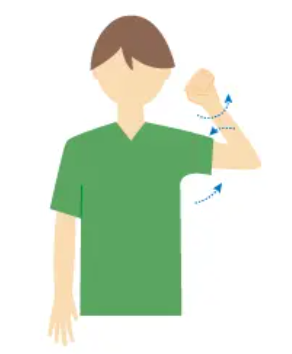
Describe this pose
This is the flexor synergy pose of the UE
scapula is retracted and elevated
shoulder is abducted and externally rotated
forearm is supinated
wrist is flexed
fingers are flexed
dominant rotation is elbow flexion
What is the weakest rotation in the flexor synergy of the UE?
shoulder abduction and external rotation
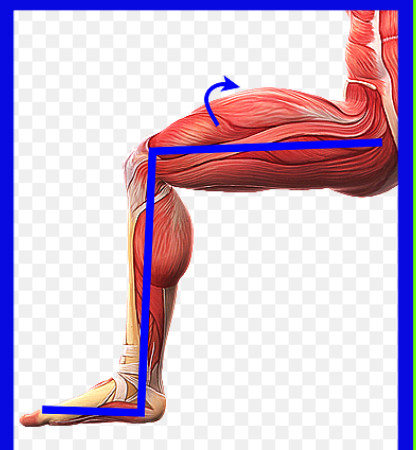
Describe this pose
This is the flexor synergy of the lower limb
hip is flexed, abducted, and externally rotated
knee is flexed
ankle is in dorsiflexion and inverted
dominant rotation is hip flexion
What is the weakest rotation of the flexor synergy of the lower limb?
hip abduction and external rotation
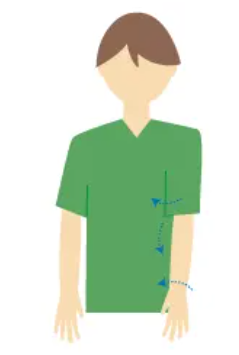
Describe this pose
This is the extensor synergy of the upper limb
scapula is protracted and depressed
shoulder is adducted and internally rotated
elbow is extended
forearm is pronated
wrist is extended or flexed
fingers are extended or flexed
dominant rotation is shoulder adduction and internal rotation
What is the weakest rotation in the extensor synergy of the upper limb?
elbow extension

Describe this pose
Extensor synergy of lower limb
hip extension, adduction, and internal rotation
knee extended
ankle is plantar flexed and inverted
toes are flexed
dominant rotation is hip adduction, knee extension, and ankle plantar flexion
What is the weakest rotation in the extensor synergy of lower limb?
hip extension and internal rotation
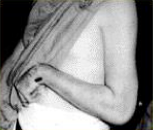
Describe this image
Adducted/Internally rotated shoulder
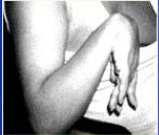
Describe this image
flexed wrist
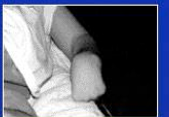
describe this image
pronated forearm

describe this image
clinched fist
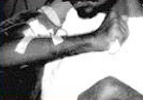
describe this image
flexed elbow

describe this image
thumb in palm deformity
Brunnstrom stage 1 for hemiplegic arm
Flaccidity/No movement
Brunnstrom Stage 2 for hemiplegic arm
Developing synergies
Brunnstrom Stage 3 for hemiplegic arm
Beginning voluntary movement within the synergy pathways
Brunnstrom Stage 4 for hemiplegic arm
Initial movements that deviate from synergy
Brunnstrom Stage 5 for hemiplegic arm
Independence from basic synergies
Brunnstrom Stage 6 for hemiplegic arm
Isolated, near normal movement with minimal spasticity
Brunnstrom Stage 1 for hemiplegic hand
Flaccidity
Brunnstrom Stage 2 for hemiplegic hand
Little or no active finger flexion
Brunnstrom Stage 3 for hemiplegic hand
Mass grasp, use of hook grasp but no release; no voluntary finger extension possibly reflex extension of digits
Brunnstrom Stage 4 for hemiplegic hand
Lateral prehension, release by thumb movement, semivoluntary finger extension, small range of motion
Brunnstrom Stage 5 for hemiplegic hand
Palmar prehension; possibly cylindrical & spherical grasp, awkwardly performed & with limited functional use; voluntary mass extension of digits, variable range
Brunnstrom Stage 6 for Hemiplegic hand
All prehensile types under control; skills improving; full-range voluntary extension of digits; individual finger movements present, less accurate than on opposite side
What are assessments that can be conducted based on Brunnstrom?
sensory testing
associated reactions and reflexes
presence of limb synergies
amount of movement a client can generate
tests of motor speed
prehension ability in hand
Fugl-Meyer Assessment of Motor Function
Comprehensive exam used to evaluate patients with hemiplegia from a stroke
Ordinal scoring for FMA
0 = cannot be performed
1 = can be partly performed
2 = can be performed faultlessly
What does the total score range from in the FMA?
0 (flaccidity) to 100 (normal)
What are treatment goals for Brunnstrom stages 1 to 2?
facilitate increased tone
promote limb synergy development
What are the treatment goals for stages 2 to 3?
promote full voluntary control of limb synergy
tone will be at peak in stage 3
What are the treatment goals of stages 4 to 5?
Encourage moving out of limb synergy to isolated and complex patterns
tone should decrease
What are the treatment goals for Brunnstrom stages V to VI?
develop more isolated and complex movement
increased speed of movement
What are tonic reflexes and how are they used in Brunnstrom interventions?
Tonic reflexes are primitive reflexes (like ATNR, STNR, tonic labyrinthine) that can be triggered after neurological injury. They are used to facilitate or inhibit movement in the affected limb (e.g., head turn toward/away from the affected side).
Give an example of using tonic reflexes in stroke rehabilitation.
Turning the head toward the affected side may elicit increased tone or movement in that side.
What are associated reactions in the Brunnstrom approach?
Involuntary movements in the affected limb triggered by effort or activity in another body part.
Example of associated reactions in stroke rehab?
Squeezing the unaffected hand tightly may cause involuntary flexion in the affected hand.
How are cutaneous and stretch/proprioceptive stimuli used in Brunnstrom interventions?
Sensory input (like skin stimulation, tapping, stretching, or weight bearing) helps facilitate muscle activation and improve awareness of the affected limb.
Example of a proprioceptive stimulus intervention?
Having the patient bear weight on the affected arm to promote joint stability and muscle activation.
Why is positioning important in the Brunnstrom approach?
Positioning reduces abnormal synergies, prevents contractures, and encourages functional use of the affected side.
Example of a positioning intervention?
Placing the patient in side-lying on the affected side to increase awareness and provide proprioceptive input.
How does facilitation of balance reactions help in Brunnstrom rehabilitation?
Balance challenges (like shifting weight or reaching) encourage more normal movement patterns and discourage reliance on primitive synergies.
Why are limb synergies both helpful and limiting in stroke recovery?
They can help initiate early movement but limit independence because they are stereotyped, not functional.
What is the proprioceptive neuromuscular facilitation approach?
PNF focuses on awareness of body position and movement, through specific commands and curs directed at muscles and nerves to help client achieve a new movement pattern
When was PNF developed? By who?
Developed in 1940s by Kabat, Knott, and Voss
How is dysfunction and function evaluated by PNF?
Manual and observational skill
What is the main premise of PNF?
In normal movement the brain registers the entire movement, not the individual component parts
What are the characteristics of PNF mass movement patterns?
They are rotational and diagonal and involve the entire body - head, neck, trunk, and limbs
How do PNF movement patterns relate to functional activities?
They resemble everyday tasks like putting on a seat belt, taking out a sword, donning earrings, or combing hair
What does PNF propose about the role of the trunk in movement?
The trunk is the foundation of movement
How many planes of movement do PNF patterns incorporate?
All three planes of movement simultaneously (Sagittal, frontal, transverse)
What sensory modalities are involved in PNF treatment?
Multisensory: visual, auditory, and tactile
What types of conditions can PNF be useful for?
Assessment and interventions with neurological, orthopedic, and traumatic injuries
What are the five critical key concepts of PNF?
1) Resistance
2) Stretch
3) Irradiation
4) Traction or approximation
5) Body positioning
What is the purpose of resistance in PNF?
To improve strength of muscle contractions
What is the purpose of stretch in PNF?
Used to improve ROM and flexibilityIr
What is the purpose of irradiation in PNF?
A strong contraction in one muscle group can lead to contractions in weaker muscle groups, therefore overflowing the body with activation signals.
What is the purpose of traction or approximation in PNF?
Elongation or compression of limbs and trunk to facilitate motion or stability
What is the purpose of body positioning in PNF?
Starting with the most stable position will help to progress to more challenging positions
What are the two primary movement of PNF?
D1 and D2
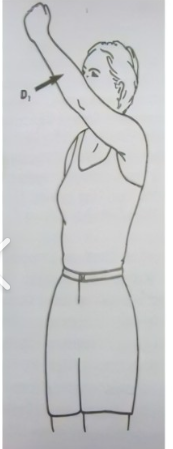
What position is this?
D1 Flexion
What muscle actions are occurring during D1 flexion?
Shoulder flexion, adduction, and ER
Forearm supination
Wrist radial deviation, flexion
Finger flexion
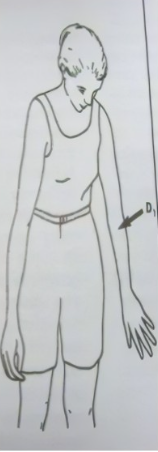
What position is this?
D1 Extension
What muscle actions are occurring during D1 Extension?
shoulder extension, abduction, and IR
forearm pronation
wrist ulnar deviation and extension
finger extension
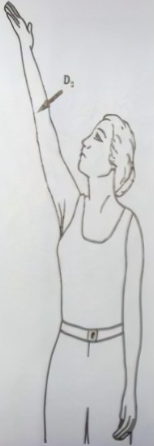
What position is this?
D2 flexion
What muscle actions are occurring during D2 flexion?
Shoulder flexion, abduction, and ER
forearm supination
wrist radial deviation, flexion
finger extension
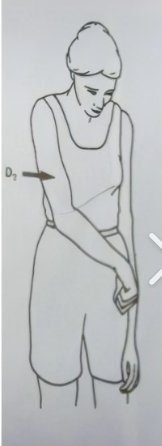
What position is this?
D2 extension
What muscle actions are occurring in D2 extension?
shoulder extension, adduction, IR
forearm pronation
wrist ulnar deviation, extension
finger flexion
What is rhythmic initiation in PNF?
A technique that progresses from PROM → AAROM → AROM, often cued with “relax and let me move you.”
What is the purpose of rhythmic initiation?
To teach the movement pattern, improve coordination, and help patients relax into motion
What is repeated contracted in PNF?
A technique using repeated resistance of a movement to increase strength and endurance
What is slow reversal in PNF?
Alternating movement through the diagonal pattern in both directions (agonist → antagonist).
What is slow reversal hold in PNF?
Same as slow reversal but with an isometric hold at the end of each movement to build stability.
What is rhythmic stabilization in PNF?
Alternating isometric contractions at mid-range to improve static strength and postural stability.
What is contract-relax in PNF?
A stretching technique: the muscle contracts against resistance, then relaxes and is passively stretched further.
What is hold-relax in PNF?
Similar to contract-relax but uses an isometric contraction before relaxing into a stretch.
What is chopping in PNF?
A bilateral asymmetrical D1 extension pattern, often used to improve trunk control and strengthen diagonal movements.
What is lifting in PNF?
A bilateral asymmetrical D2 flexion pattern, used to facilitate coordinated trunk and upper extremity movement.